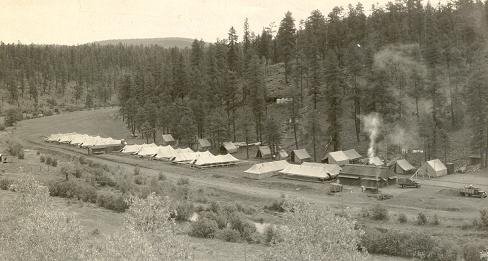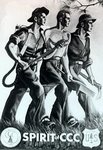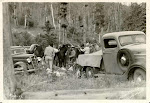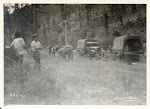 Our second Spotlight Site is entitled The Look of Nature: Designing Texas State Parks During the Great Depression. The site is operated by the Texas Parks and Wildlife Department and it’s an absolutely outstanding resource for learning about the work of the CCC in 29 Texas parks.
Our second Spotlight Site is entitled The Look of Nature: Designing Texas State Parks During the Great Depression. The site is operated by the Texas Parks and Wildlife Department and it’s an absolutely outstanding resource for learning about the work of the CCC in 29 Texas parks.
Visitors to the site can browse through an interactive Archive of CCC related images, view specific Park Profiles and work through an Interactive Program. There are even video clips and oral histories available at the site.
Texas in particular seems to have a special understanding of the importance of the CCC and its history, which at times seems a bit ironic given that many Texas enrollees were actually shipped out of state to perform CCC work in other states such as Colorado and Arizona. Regardless of how many may have been shipped to other states to work, the enrollees who labored on in Texas made an indelible imprint on the history of the state and their important work is nicely commemorated on this Texas Parks and Wildlife Department Site. Be sure to visit and save it as a favorite.
Tuesday, April 27, 2010
Spotlight Site: Texas Parks & Wildlife Department's "The Look of Nature"
Posted by
Michael
at
8:07 PM
2
comments
![]()
Labels: Spotlight Site
Monday, April 19, 2010
Revisionist History: Leave the CCC Out of It
Would you tell these guys the CCC was a failure?
It is refreshing to see that the authors of the latest revisionist editorial to come out against the New Deal have wisely chosen to leave out any mention of the most popular and arguably the most successful New Deal program, the CCC.
Burton and Anita Folsom, who both hail from Hillsdale College, wrote earlier this month (ironically, on the anniversary of FDR’s death) that the New Deal did nothing to end the Great Depression. The editorial appeared in the Wall Street Journal and you can read it Here.
Referring to the many “alphabet agencies” created during the New Deal, Folsom and Folsom state that “…the WPA, AAA, NRA and even the TVA (Tennessee Valley Authority) failed to create sustainable jobs.” (I think someone working for the TVA today would beg to differ but that’s an argument they’ll have to make.) For my part I see it as a sign of progress that nowhere in the Folsom’s editorial is there any reference made to the CCC, the ECW or the Civilian Conservation Corps.
I’ve stated many times over that I am not an economist and I’m really not much of an historian and I don’t pretend to be. I’ve made a study of the CCC but when it comes to the larger impacts of the New Deal, I’ll defer to anyone with a reasonable argument. However when a revisionist historian props up their argument by making spurious claims about the CCC, they’d better have their facts straight. For this reason, I’m inclined to applaud the Folsom’s, at least for their having had the good sense to leave the CCC out of it.
I’m reminded of a revisionist rant that came out about five years ago from a gentleman by the name of Richard Ebeling – also associated with Hillsdale College at the time. Mr. Ebeling penned a piece entitled “When the Supreme Court Stopped Economic Fascism in America,” in which he made the following, stunning claim about the Civilian Conservation Corps:
“Much of the urban youth of America were rounded up and sent off to national forests for regimentation and mock military-style drilling as part of the Civilian Conservation Corps (CCC).
You can read the entire editorial here: Richard Ebeling's Article.
I won’t bother to expound on the many ways in which Mr. Ebeling’s claim is outlandish and stupid – he’s a professor of economics who should probably stick to economics – but I will offer some commentary on why I think the Folsom’s were right to leave the CCC out of their argument.
The CCC was not established to create sustainable jobs. If anything the CCC was geared toward removing single, teenaged men from the workforce in order to open up jobs for older men who were often unemployed heads of households. Furthermore, the CCC was created with the goal of improving the health and well being of its enrollees while providing them a chance to help their families through their own hard work (real self-esteem building, not the phony stuff sociologists spout about today). The money an enrollee sent home every month was plowed back into the economy in the form of rent payments and weekly grocery purchases. The CCC wasn’t a cure all and nobody with a lick of sense will attempt to argue that it was. By the same token, nobody with a lick of sense would reasonably claim the New Deal was a failure because of anything the CCC did, except perhaps with respect to its failure to racially integrate the camps.
I’m pleased that we can still discuss the New Deal on its merits and I’m pleased that supporters and detractors can all have their voices and opinions heard. I’m especially pleased that in the last five years or so, we’ve at least learned where the salient arguments are to be made and that the success or failure of a single New Deal program isn’t sufficient evidence for either side and that perhaps the CCC in its own right has risen above the discussion about whether or not the New Deal brought us out of the Great Depression.
To see an earlier editorial regarding revisionist works by Amity Shlaes (The Forgotten Man) and James Powell (FDR’s Folly) see my post entitled The Folly of Revisionist History.
Posted by
Michael
at
4:28 PM
0
comments
![]()
Labels: Amity Shlaes, Editorial, Jim Powell, Revisionist
Tuesday, April 6, 2010
Semper Patria Mea: A New Look For Camp Commanders
 We now know when the insignia worn by the camp staff was changed. But why?
We now know when the insignia worn by the camp staff was changed. But why?
Larger developments and policies that shaped the program between 1933 and 1942 are widely known or at least vaguely understood but often the little facts behind the implementation of the policy are seemingly lost to history – buried deep in a stack of boxes in the National Archives perhaps.
Folks who’ve made a study of the CCC will have noticed that at some point in the lifespan of the program, the officers who ran the camps switched uniforms and their insignia changed from the familiar insignia of the U.S. military to an insignia created specially for the CCC. Bob Audretsch has located an article that spells out this change in the April 13, 1940 issue of Happy Days.
 Under the headline "Eagle and Latin Phrase for Officers", the article reads:
Under the headline "Eagle and Latin Phrase for Officers", the article reads:Washington, D.C. – CCC camp officials are to get a new corps insignia to replace the regulation one now used on CCC uniform hats. Devised by the war Department on request of Director James J. McEntee, the insignia will resemble the drawing above. Specifications now are being drawn by the Army Quartermaster.
The design, somewhat similar to that of the Army, will be of jewelry bronze, 2 ½ inches high, with raised letters. The Latin quotation at the bottom, “Semper Patria Mea,” means “Always My Country.” It was chosen by Director McEntee. The design was executed by the heraldry office of the War Department.
The reason for the switch lies buried in a bureaucratic maneuver that took place in 1939. The War Department was never 100% on board with participation in the CCC program; they were a reluctant partner at first and eventually grew into a grudging participant, having recognized a number of benefits that could be derived from their participation in the CCC program. Nevertheless the relationship between CCC Director Fechner and the War Department was never a close one and by 1939 the War Department was taking steps to have itself absolved of responsibility for the camps.
A move by Congress in April 1939 only served to push the divorce along. On April 3rd Congress voted to give full disability benefits to Reserve officers assigned to active duty with the CCC; this was an expense the Roosevelt administration could not sanction and in response he decided to replace all Reserve officers assigned to CCC camps with civilians and the changeover was complete by the end of 1939. Nevertheless, the War Department remained in control of the camp administration, but the change in policy explains why the insignia of camp personnel was undergoing the changes that are outlined in the short piece from the April 13, 1940 issue of Happy Days. (I’ve drawn on John Salmond’s book The Civilian Conservation Corps: 1933-1942 for background on the change in policy.)
Who knows what other tidbits one is likely to turn up in poring over the old issues of Happy Days newspaper? Future researchers will certainly owe a dept of thanks to Bob Audretsch for his work in compiling the Arizona index for Happy Days. Perhaps other researchers would consider undertaking a similar indexing project for other states. Imagine if stories for all the states and territories were indexed for Happy Days. What a gold mine that source would become.
Posted by
Michael
at
8:53 PM
0
comments
![]()
Buffalo Crossing Camp, Eastern Arizona













